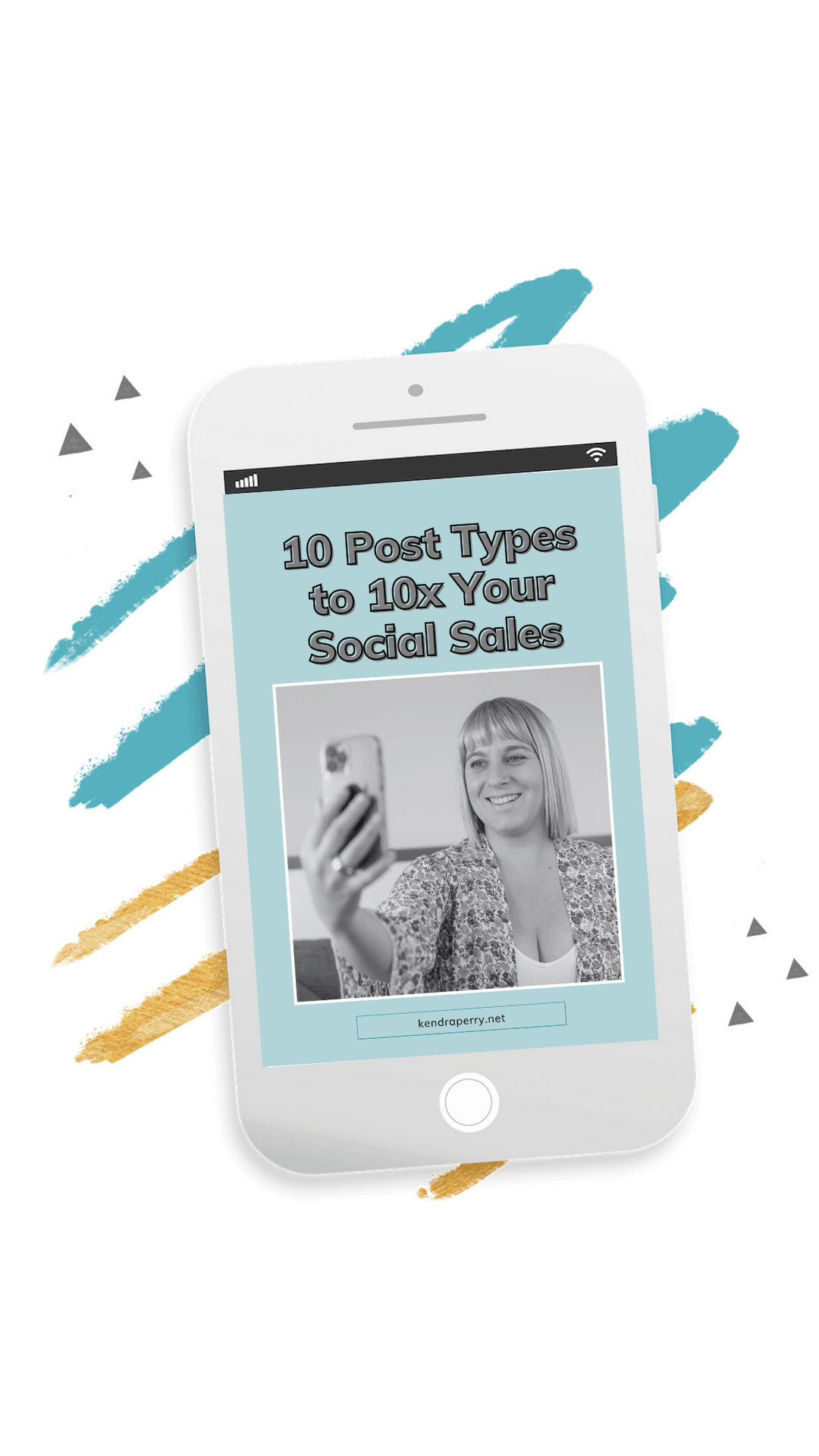Are you pricing your coaching programs too low? Are you charging your clients fairly? If you want to figure out a money-making price point for your program, this is the episode for you! How you price your program is how you earn money and cover your business’s expenses and costs. You don’t just want to pull a number out of thin air. Listen in as Kendra Perry shares practical tips and business insight on do’s and dont’s when it comes to charging your clients.
Join the Craft Your Signature Offer Challenge: bit.ly/signatureofferchallenge
—
Listen to the podcast here:
Choose A Money-Making Price Point For Your Program
If this is your first time, I’m an online business mentor for health and wellness coaches and practitioners. I’m here to help you blow up your business and start making $10,000 per month. In this episode, we are talking about a topic that I get asked about time and time again. One of the most common questions I get asked is, “Kendra, what do I charge? What do I price? How do I pick a price point?” It’s probably an internal battle that you have struggled with inside your head.
When I was a new health coach, I was all over the map with my pricing. I didn’t know what to charge because you don’t know, and I didn’t know. I was like, “Do I charge this? Is this too high? Is this too low?” You have no idea. What I learned in my diploma program for nutrition was essentially to charge hourly. If you have read this show for any amount of time, I talk about the value of signature programs. It’s really valuable.
If you don’t know what a signature program is, go back to episode 104. That’s a couple of episodes back. I will tell you all about what is a signature program and do you need one? Is it important? The answer is yes, you need one. Every business needs a signature program. When we talk about pricing in this episode, I’m not talking about your hourly rate. We are throwing your hourly rate essentially out the window, and we are focusing on the price of your signature program.
If you are like, “I have read it so many times. You are a broken record. I know I need to build my signature program,” but you don’t know how to build it. You have no idea what to put in it, what topic it should be about, how to brand it or sell it, and all of those things. I invite you to join my free five-day challenge, the Craft Your Signature Offer Challenge.
If you are reading this before 9:00 AM Pacific, you can hop into the Facebook Group and catch the first training. In this five-day challenge, I’m going to go through the topic that your program should be to attract your audience. We are going to talk about how to build your program from scratch so that it’s exactly what your audience and future clients want. We are going to talk about branding and how to connect your program with your brand, naming, and finally, we are going to go deeper into the pricing of your program, which is a little bit about what we are going to talk about in this episode. If you want to join, you can go to Bit.ly/signatureofferchallenge.
Let’s dive into pricing. First off, it’s important to price intentionally when it comes to deciding what to charge. What a lot of people are doing is they’re just coming up with a random number in their head. That’s why they get stuck because it’s a random number, so when you come up with it, you have essentially pulled it out of your butt. You are going to go back and forth on it because it has no anchoring in reality. You are going to be like, “Is this right? Is it not right?” It might be right or not, and you won’t know because you haven’t anchored it to anything real.
Another thing coaches will do is will price based off the length of their program. They think if it’s longer, it’s more valuable. There is going to be more time with you but if you want to make your program more valuable, making it longer is not the way to do it. Your program should only be the minimum amount of time that you need to get them towards the result. Don’t make a program five months when you could probably get most of the way there in 3 or 4 months. It should be the minimum amount of time that you need.

The other thing coaches will do is they will price based on competition. This is common. I see this all the time with my health coach accelerator students. They are like, “So-and-so is charging this much money.” Don’t base it on the competition. That’s not rooted in your reality. Pricing needs to be anchored to you and not to someone else’s reality because that person who’s charging $5,000 a package, you don’t know what their experience is and expenses are. Maybe they have 4 kids, 3 mortgages or they’ve got a lot of stuff to pay for, so they need to charge higher to do that.
The person who’s only charging $1,000, maybe this person is single, has a rent-controlled apartment, doesn’t have a lot of expenses, and doesn’t need much. That’s the problem we come up against when we charge randomly. It’s important to be intentional. What I’m going to do is help you implement this simple formula that will anchor your pricing in reality.
When it comes to pricing, the most important place to start is you want to make sure all your stuff is covered. What I see a lot of coaches do is they pull a price out of their butt. What happens is they can’t pay their bills or expenses, and the price they have chosen is so low or unbelievably unrealistic that it doesn’t matter how many they sell. It’s basically impossible to get to the point where they are paying off their expenses and have the extras to live the lifestyle that they want.
It all starts with taking a look at your money. I know this can feel uncomfortable. A lot of people don’t want to look at their money. You are an entrepreneur, so you have to get comfortable with looking at your money and expenses. We want to know two different types of expenses, personal and business. How much is your mortgage or rent? How much are you spending on groceries, gas and utilities? All of those things go over your credit card or bank account for the last few months and try to come up with a general average of what you need each month to feel comfortable and pay those expenses.
You are going to need to do the same thing with your business expenses. I put all my business expenses on one credit card, so it’s easy for me to figure out my baseline expenses every month. Sometimes it’s more, sometimes you invest in some other one-time thing but typically there are a few base-level subscriptions that you are like, “I need these subscriptions to run my business.” Maybe that’s practice better, click funnels or a sauna. Whatever it is, go look at that and figure out what you are spending, in general, each month for your business.
Now you have determined your expenses. These aren’t the only numbers that we need to know. I’m a huge proponent of always putting money away into savings. I call this the oh f*** account. Just in case crap go sideways, you get injured, there’s a family emergency or something happens where you need to take a bit of a step back from your business or maybe you are going through a period where you have a bit of a hard time because the marketing landscape has changed, which happens sometimes. I like to set myself up with a minimum of six months that will cover my personal and basic business expenses. That’s what I like to build towards. You should try to build towards that, too.
Maybe you are like, “I don’t even come close to that.” That’s okay, but you should start putting away money each month, even if it’s only a few percent or $50. Put that into a savings account, so you have it and you can start building up that emergency account. The fourth number you need is your taxes. How much money should you be putting away each month for your taxes? At the end of the year, when you get your tax bill because it’s not like you are an employee where your employer automatically takes your taxes for you, now you have to put away your own money for taxes.

This is a good question to ask an accountant. I can’t tell you what it will be. It could be 15% or 40%. It truly depends on where you live in the world, what state or province. Talk to your accountant and try to figure out, “In general, how much should I be put away each month of my income for taxes?” Those are the four things you want to know. The other thing that you will want to put in there because you can do this twice, and this is your bare-bones. This is what you need to survive but I don’t want you to just surviving. Obviously, I want you thriving. I want you wealthy and do all those fun, fancy things that you want to do.
Create a bit of a wishlist. This could be, “I want to get a massage every month. I want to go away for a weekend every month and get a nice Airbnb,” or whatever it is. Figure out what you would want each month to be able to have all those extras. That can be your dream price point. This is going to be your growth. This is essentially what you need to make, gross. Take that number, put it aside, do one for bare-bones basic and one for your dream amount.
The next thing you are going to want to figure out is, “How many clients realistically can you work with a month?” If you come into my Craft Your Signature Offer Challenge, I will show you how to set up your program, so you will know what it contains, how long it is and how many appointments each client is getting. You will be able to figure out in general how much time you were spending with a client each and every month.
When you are brand new and just launched your signature program, you are going to have to track this. You can use an app called Toggl.com. It’s a simple time-tracking desktop app. You want to track all the time that you spend with each of your clients so that you can get an average of what that is. You want to be realistic. Remember, you can’t be working with clients all the time.
If you have it set up so that you are working with clients 30 hours a week, it doesn’t make sense because when are you going to do all your marketing or sales calls? I don’t think you should be working with clients. Let’s say you are doing 40 hours, then 20 hours is a max. I would probably say fifteen hours a month because you need that other time for all the other things that you need to do in your business. Let’s say that you have determined, “Realistically, with this program, I can probably take on five clients a month.” Take that gross number, divide it by five and now you have your price point.
Let’s say that your gross is $10,000. I’m using $10,000 because it’s an easy even number. Let’s say you have decided that, “I can work with five clients a month,” then your price point is $2,000. If you feel like, “I can’t charge $2,000. That’s so much money. I feel overwhelmed by that,” that’s fine. You can start at a place you are comfortable with but you are going to need to know that you are going to have to make up that income in some other way or you are not going to get there. You are not going to be able to pay your bills. Maybe that’s a part-time job or some other way to make money but that’s essentially how you are going to do this.
You could take on another client but that’s not realistic and you are going to get bogged down. It may be that you need to shorten the amount of time that you spend with clients inside that program. Instead of offering 4 appointments a month, maybe you do 3. Hopefully, what you can see is it’s intentional and rooted in reality. We are anchoring it to the intentional lifestyle that we ultimately want. With that dream price point, maybe that’s $20,000 and you are like, “If I had an extra $10,000 a month, that would be great. I could use that to go to the Airbnb, get that massage, do that acupuncture,” or whatever it is and then you know what price point you are working up to.

This is intentional and you won’t get stuck with it. The only way you are going to get stuck is with the mindset and with the, “Am I worthy of this price point?” That’s a whole other topic. If you don’t believe you are worthy of the price point that you need to charge, then this is a self-worth issue. This is a self-love wound that will need to be worked on. We will talk about that in another episode.
I’m going to quickly tell you how you can raise your prices with confidence. Let’s say you are like, “I need to charge $2,000 but I’m not quite confident enough to do that. I’m going to start with $1,000.” Figure out another way to make up that extra income, start with $1,000 and keep your prices off your website because you are going to be changing your prices regularly. That’s not the only reason you don’t want them on your website. There are a lot of other reasons to keep your prices off your website.
One of them is because you are going to continually raise your prices. First off, you are going to choose a frequency at which you are going to raise your prices. Do this per client because truly, you only get more valuable as a coach with each and every client with the experience. It’s not the courses or the time. It’s the clients. Maybe you are going to raise your prices for every 2, 3, 4 or 5 clients. Choose one frequency of client.
The next thing you are going to do is choose, “How much am I going to raise my prices with each client?” You can choose a dollar amount. Maybe it’s $30, $50, $100 or you can choose a percentage. Maybe it’s 2%, 5% or 10%. You have to choose that but make sure you stick to it. This is how you can do it with confidence because you are anchoring your price increase in reality. The reality is you have more experience because you have worked with more clients, which makes you a more valuable and more powerful coach. I hope that makes sense.
If you want to build your signature program with me, we are doing that inside the Craft Your Signature Offer Challenge group. If you missed it, no problem. You can watch the replay and then tune in for the rest of the week. If you want to join, you can go to Bit.ly/signatureofferchallenge. It’s awesome to hang out with you. I will see you next time, same time, place, where I help you become wealthy AF.
Important Links:
- Craft Your Signature Offer Challenge
- Facebook Group – Craft Your Signature Offer: 3-Day Challenge
- Bit.ly/signatureofferchallenge
- Toggl.com






